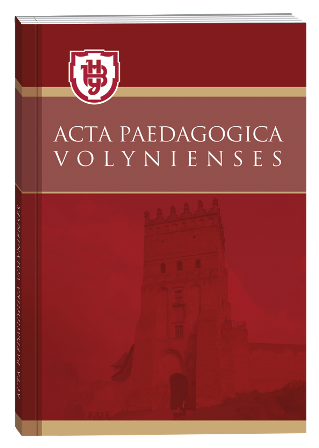APPLICATION OF SENSORY INTEGRATION ELEMENTS IN SPEECH THERAPY WORK WITH PRESCHOOL CHILDREN
DOI:
https://doi.org/10.32782/apv/2021.4.23Keywords:
general speech underdevelopment, preschool children, sensory integration elements, correctional and developmental work, speech therapy classesAbstract
The article highlights the problem of including sensory integration elements in speech therapy work with preschool children with general speech underdevelopment. It is noted that sensory and speech development are closely related, and that the speech disorders causes are disorders related to the sensory information processing, so one of these disorders correcting means may be sensory integration method. The speech examination results of preschool children with general speech underdevelopment according to the speech examination method of children aged 4-7 of O. Zaitseva and V. Sheptunova at the ascertaining and control study stages are highlighted. The implementation principles of which should be based on the inclusion of sensory integration elements in the speech therapy system: development, individual approach, trust and cooperation, child activity, clarity, humanism and pedagogical optimism. Examples of the equipment use of the Sensory Center (sensory paths, cereals, dry pool, sand, balancer) in speech therapy classes in order to correct speech disorders and its development are given. It is noted that the sensory equipment use allows children to perform a variety of subject-practical and playful activities that promote the development of fingers fine motor skills, improving prosodic speech components, auditory perception and phonemic processes development, lexical and grammatical categories formation, speech disorders correction, development coherent speech, as well as sensory functions stimulation, motor activity, removal of muscle and psycho-emotional tension, creating a positive emotional background, cognitive processes activation, increasing motivation for joint with adults and independent activities of preschoolers.
References
Айрес Э.Дж. Ребенок и сенсорная интеграция. Теревинф, 2017. 277 с.
Богуш А.М., Луцан Н.І. Мовленнєво-ігрова діяльність дошкільників: мовленнєві ігри, ситуації, вправи. Навчально-методичний посібник. Київ : Видавничий Дім «Слово», 2008. 251 с.
Заплатинська А.Б. Технології «сенсорної інтеграції» в системі корекційної психолого-педагогічної роботи з особами із порушеннями психофізичного розвитку. Матеріали науково-практичної конференції з міжнародною участю, м. Львів, 31 серпня – 1 вересня 2012 р. Львів, 2012. С. 65–71.
Зайцева Е., Шептунова В. Тестовая методика обследования речи детей 4-7 лет. Каро, 2015. 72 с.
Камінська О., Закревська А. Сенсорна інтеграція, або Як допомогти кожній дитині. Дошкільне виховання : наук.-метод. журнал для педагогів і батьків. 2017. № 11. С. 24–29 .
Литвин Н.І., Борецька О.В., Сойко О.В. Комплексна психолого-педагогічна реабілітація дітей з особливими потребами засобами сенсорної інтеграції. Психологія: реальність і перспективи : збірник наукових праць РДГУ. 2018. Вип. 10. С. 94–100.
Митрофанова А.Е. Развитие речи у детей с задержкой речевого развития с помощью сенсорных игр и упражнений. Теория и практика образования в современном мире : материалы II Международной научной конференции, г. Санкт-Петербург, ноябрь 2012 г. Санкт-Петербург, 2012. С. 149–150. URL: https://moluch.ru/conf/ped/archive/64/2947/
Скрипник Т. Сенсорна інтеграція як підґрунтя цілісного розвитку дітей з аутизмом. Особлива дитина: навчання і виховання. 2016. Вип. 4 (80) С. 24–31.
Теорія сенсорної інтеграції Джин Айрес та її застосування у дитячій нейрореабілітації. Здоров’я України. 2012. С. 42–43. URL: http://health-ua.com/pics/pdf/ZU_2012_Nevro_4/42-43.pdf
Фаласеніді Т.М., Козак М.Я. Порушення сенсорної інтеграції у дітей з особливими потребами. Молодий вчений. 2017. № 9 (49). С. 102–105.







